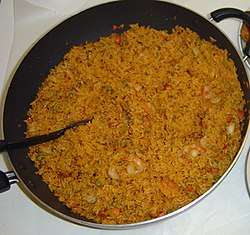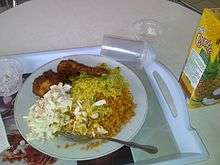Jollof rice
 Jollof rice | |
| Alternative names | Benachin, riz au gras, theibou dienn |
|---|---|
| Type | Rice dish |
| Region or state | West Africa[1][2] |
| Main ingredients | Rice, tomatoes and tomato paste, onions, cooking oil, Goat meat or Beef |
Jollof rice /ˈdʒɒləf/ or just jollof, also called Benachin (Wolof: "one pot"), is a one-pot rice dish popular in many West African countries.[3][4][5]
Geographical range and origin
Jollof rice is one of the most common dishes in Western Africa, consumed throughout the regions of Gambia, Senegal, Ghana, Sierra Leone, Nigeria, Togo, Liberia, Mali, Ivory Coast and Southern Cameroons. In Cameroon it is a common favorite at ceremonies such as weddings, graduations and birthdays and is sometimes cooked with "ndole", a local vegetable. There are several regional variations in name and ingredients.[1] The name Jollof derives from the name of the Wolof people,[6] though in Senegal and Gambia the dish is referred to in Wolof as theibou dienne or benachin. In French-speaking areas, it is called riz au gras. Despite the variations, the dish is "mutually intelligible" across the region, and has spread along with the diaspora to become the best known African dish outside the continent.[2][5]
Based on its name, the origins of jollof rice can be traced to the Senegambian region that was ruled by the Jolof Empire. Food and agriculture historian James C. McCann considers this claim plausible given the popularity of rice in the upper Niger valley, but considers it unlikely that the dish could have spread from Senegal to its current range since such a diffusion is not seen in "linguistic, historical or political patterns". Instead he proposes that the dish spread with the Mali empire, especially the Djula tradespeople who dispersed widely to the regional commercial and urban centers, taking with them economic arts of "blacksmithing, small-scale marketing, and rice agronomy" as well as the religion of Islam.[2]
Ingredients

The dish consists of rice, tomatoes and tomato paste, palm oil, onions, salt, spices (such as nutmeg, ginger, and cumin) and chili peppers (such as Scotch bonnet); optional ingredients can be added such as vegetables, meats, or fish.[7] Due to the tomato paste and typically used red palm oil, the dish is mainly red in colour.[5] The recipe differs from one region to another.
Nutrition
The main ingredients of jollof rice are rice and tomatoes; neither has any saturated fat or cholesterol.[8] The addition of palm oil does add saturated fat. Jollof is primarily carbohydrates, as it is a rice dish. Since jollof is often served with chicken, beef, eggs and/or turkey, it is complemented by the protein from those accompanying dishes. Fish is sometimes used as an accompaniment, and can provide the dish with omega-3 fatty acids, as well as protein.
Presentation
On the event of special occasions such as birthdays, weddings or baby showers, the dish can be presented and served made into shapes, overall a more formal presentation of the dish. As an option, fried plantain can also be placed on top, or beside the jollof rice, and then various meats are added around the rest of the dish.
Nigerian and Ghanaian debate
There are multiple regions in Africa who debate over the geographical origins of jollof rice. However, one of the most vigorous jollof rivalries has been between Nigerians and Ghanaians. The main argument in this debate is currently centered on which country's version tastes better. The reason for the debate is due to the huge popularity of jollof, in regards to West African cuisine. Both Nigeria and Ghana have shown consistent competitiveness over the debate as to who can serve the dish the best.[9] The debate has gone so far as to even having organized contest shows like the Jollof Festival in Washington, DC, [10] in order for famous critics from all over the world to taste, examine the differences, and give their overall judgments on either forms of the dish. Recently, social media has also become a popular tool for people to share pictures, and opinions over who serves the dish the best.
Nigerian jollof
Although considerable variation exists, the basic profile for Nigerian jollof rice includes long grain parboiled rice, tomatoes and tomato paste, pepper, vegetable oil, onions and stock cubes. Most of the ingredients are cooked in one pot, of which a fried tomato and pepper puree characteristically forms the base. Rice is then added and left to cook in the liquid. The dish is then served with the protein of choice and very often with fried plantains, moi moi, steamed vegetables, coleslaw, salad, etc.
In the riverine areas of Nigeria where seafood is the main source of protein, seafood often takes the place of chicken or meat as the protein of choice and there are variations of the classic jollof rice; including coconut jollof rice, fisherman jollof rice (made with prawns, periwinkles, crayfish), mixed vegetables jollof rice, and rice and beans. More economically friendly versions of jollof rice are popularly referred to among Nigerians as “concoction rice,” the preparation of which can involve as little as rice and pepper.
Ghanaian jollof
Ghanaian jollof rice is made of vegetable oil, onion, bell pepper, cloves of pressed garlic, chillies, tomato paste, beef or goat meat or chicken (some times alternated with mixed vegetables), jasmine or basmati rice and black pepper.[11] The method of cooking jollof begins with first preparing the beef or chicken by seasoning and frying it until it is well-cooked[11] The rest of the ingredients are then fried all together, starting from onions, tomatoes and spices in that order. After all the ingredients have been fried, rice is then added and cooked until the meal is prepared. Ghanaian jollof is typically served with side dishes of beef, chicken, well-seasoned fried fish, or mixed vegetables.
Jollof in Ghana is also served alongside shito, a popular type of pepper which originates from Ghana, and salad during parties and other ceremonies.
See also
- African
- Asian - North American fusion
- European
- North American - European fusion
References
- 1 2 Ayto, John (2012). "Jollof rice". The Diner's Dictionary: Word Origins of Food and Drink (2nd ed.). Oxford University Press. p. 188. ISBN 978-0199640249.
- 1 2 3 McCann, James C. (2009). A west African culinary grammar". Stirring the Pot: A History of African Cuisine. Ohio University Press. pp. 133–135. ISBN 978-0896802728.
- ↑ Brasseaux, Ryan A.; Brasseaux, Carl A. (1 February 2014). "Jambalaya". In Edge, John T. The New Encyclopedia of Southern Culture: Volume 7: Foodways. University of North Carolina Press. p. 188. ISBN 978-1-4696-1652-0.
- ↑ Anderson, E. N. (7 February 2014). Everyone Eats: Understanding Food and Culture, Second Edition. NYU Press. p. 106. ISBN 978-0-8147-8916-2.
- 1 2 3 Davidson, Alan (11 August 2014). "Jollof rice". The Oxford Companion to Food. Oxford University Press. p. 434. ISBN 978-0-19-967733-7.
- ↑ Osseo-Asare, Fran (1 January 2005). Food Culture in Sub-Saharan Africa. Greenwood Publishing Group. pp. 33, 162. ISBN 978-0-313-32488-8.
- ↑ Ferruzza, Charles (October 1, 2013). "Esther's African Cuisine leaves the light on for you". The Pitch. Retrieved 2013-10-08.
Meals are served with white rice or, for an upcharge, an extraordinary concoction of rice cooked with tomatoes, carrots, onions, peas and shredded chicken called Jealof rice. 'It's the Sunday dish in my country,' [Esther] Mulbah says. It's hearty and comforting, as a side or a full meal.
- ↑ "Nigerian Jollof Rice & Chicken Recipe". Calorie Count. Archived from the original on 15 November 2016. Retrieved 15 November 2016.
- ↑ Oderinde, Busayo. "Busayo Oderinde: The Nigerian Versus Ghanaian Jollof Rice Debate". Bella Naija. Retrieved 15 November 2016.
- ↑ "Jollof Festival Washington, DC". theafricandream.net. Retrieved 9 May 2018.
- 1 2 "Ghana: Jollof Rice". The African Food Map. Retrieved 15 November 2016.